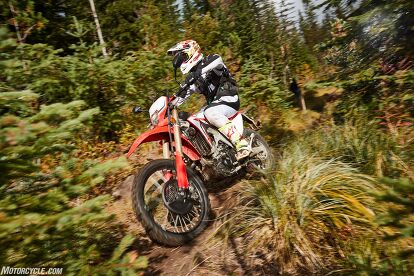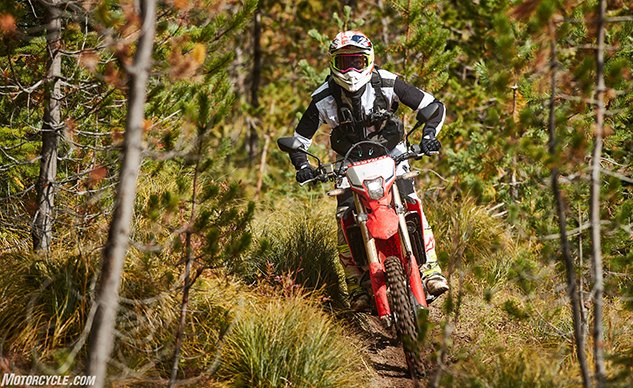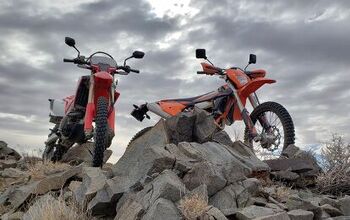2019 Honda CRF450L Review - First Ride
Hey Honda, who should I make the check out to?
Lo and behold, and thank frickin’ God, the 2019 Honda CRF450L is finally here. Every so often, a new motorcycle will come out, and it’ll shake things up and get people thinking. Perhaps it’ll make them see motorcycles in a different light, change their minds about them, or even convince them that, maybe owning a motorcycle could be awesome… Ain’t that just the craziest idea?
2019 Honda CRF450L
| Engine | 18.0/20 |
| Suspension/Handling | 14.0/15 |
| Transmission/Clutch | 9.25/10 |
| Brakes | 9.25/10 |
| Instruments/Controls | 4.75/5 |
| Ergonomics/Comfort | 9.5/10 |
| Appearance/Quality | 9.5/10 |
| Desirability | 9.75/10 |
| Value | 9.5/10 |
| Overall Score | 93.5/100 |
Well first off, duh… Yes, owning a motorcycle will instantly increase your quality of life – guaranteed. (Go ahead, convince us we’re wrong.) Like death and taxes, it’s just a fact of life. But some fun-sucking lawmakers want to limit the amount of fun you’re allowed to have by shutting down riding areas, by restricting when and where you can ride off-road, or by taking it away altogether – especially here in California, an endlessly beautiful land just waiting to be explored.
The way around that? A license plate. It gives you the freedom to ride just about anywhere and everywhere, whenever you want, on- or off-road. It gives you full year-round accessibility. While the 250 and 650L have been holding down the Honda dual-sport fort since the early ‘90s, and even after the CRF450 line was introduced in 2003, there’s never really been a solid midsize street-legal option. Sure, some people registered their XR400Rs and early CRF450Xs in the past, but most states have cracked down since (except for Arizona where you can put a license plate on a toaster) and will take the plates away, even if they were “grandfathered in” before new laws took effect, or before the DMV offices got smart.
Fortunately, there’s a new bike on the market, it’s awesome, and it’s the 2019 Honda CRF450L. Usually, I try to contain my excitement about a new bike, but the all-new 450L just checks too many of my boxes when it comes to a motorcycle, street-legal or not. To get things started, the CRF450L is a direct descendant of the CRF450R motocrosser, so it already comes with a performance-inspired pedigree, though it’s most closely related to the CRF450X trail bike. In short, the 450L is a real dirtbike at heart, and let me explain why that’s a good thing.
It basically comes down to the “all squares are rectangles, but not all rectangles are squares” logic. Meaning, dual-sport motorcycles all fall somewhere in the spectrum between off-road and street use. Some land in the middle with hopes of handling double-duty, but as a result, do neither well, while others lean to either side. A street-focused dual-sport like the Suzuki DR-Z400 is just that – street-focused. It gets around town nicely and odds are the owner bought it because they liked the look and ruggedness of a road-going dirtbike (nothing wrong with that), but take it to the dirt and you’ll quickly recognize it’s more of a street bike with dirtbike fenders than anything else.
On the other hand, if you get yourself a dual-sport that leans to the off-road side of things, like the CRF450L, you’ll get to experience the possibilities a true dual-purpose motorcycle can offer. Plus, it will ride and handle street duty just fine compared to a street-focused dual-sport (the 450L actually tackles the road with exceptional comfort and handling), but that’s not why you bought a dual-sport in the first place. Few people buy a dual-sport for heavy street use. Rather, they probably bought one with visions of riding down the road and up into the mountains/ hills/ trails/sand pits/whatever your local region offers/etc., but a streetier dual-sport will only get you so far. The 2019 Honda CRF450L will take you wherever you want.
As mentioned before, the 450L is basically the 450X with a DOT headlight, taillight, turn signals, mirrors, and a license plate. The frame, motor, six-speed transmission, and suspension are all virtually the same, save for a few tweaks that prevent the X from being street legal, but it mostly comes down to noise and emissions related differences. To keep road noise levels down and the EPA happy, the CRF450L’s clutch, stator and front sprocket all have an extra cover. Did those covers provide a noticeably quieter engine? I’m not sure, most likely, but they definitely do bring extra bash protection to the table, and we’re all for that – just ask Ryan.
The 450L’s swingarm is also urethane-injected, and both the front and rear sprockets have a rubber gasket on them to further dampen any sort of road noise or chain slap. The combination of these changes definitely made a big difference in the amount of mechanical noise of moving parts you hear, especially while riding on the street. Other differences between the X and L which make the L more user-friendly for the road are full LED lighting, a lightweight lithium-ion battery with increased capacity, and a more powerful AC generator to power electrical components such as a GPS, heated grips or even a phone charger. The CRF450L is a no-bullshit bike.
We rode a 100-mile loop around Packwood, Washington and the Gifford Pinchot National Forest, which is basically dual-sport heaven, if you ask me, and 80% of it was off-road. From fire roads and single-track to gravel pits and hill climbs, and everything in between, there wasn’t anywhere a regular, non-street-legal dirtbike could go where the CRF450L couldn’t. The 450L can be ridden as aggressively and tortured just as hard as a regular dirtbike. In fact, it can probably take an even heavier beating all while providing a smoother, less tiring ride. It’s beefed up in a lot of the right places.
Based on my experience with the CRF250L Rally, I feared the 450L’s 12.0:1 449.7cc motor would have an embarrassingly neutered and reduced power output and engine character compared to its non-street-legal kin. Thank the motorcycle gods (and Honda engineers) I was wrong. While the L runs out of steam a little earlier and doesn’t pull as strong on the top-end of the RPM range as the R and RX models do, it still hits plenty hard everywhere else, with incredibly linear and usable power. According to our butt dyno, we’d peg the L somewhere in the mid-40s, much more than the rumored 25 hp seen in some places on the Internet – damn trolls, go back to playing Fortnite. The CRF450L’s ECU is of course mapped differently, with tractability and user-friendliness as the main goal. It’s also got a heavier flywheel with a 12% higher crank inertia over the CRF450R, which makes riding the L through slow, technical terrain easy. The L even has dedicated valve timing for smoother power delivery in the tricky stuff.
Speaking of the tight, tricky stuff, the 450L also has larger-capacity radiators with higher heat-exchange efficiency and dual electric fans to prevent overheating when conditions get extra brutal. Very rarely did the CRF450L’s motor leave me wanting more power. Like I mentioned, it doesn’t have the overrev the R and RX models do, but fortunately with its six-speed transmission, there’s always another gear just a click away. It seems Honda engineers did their homework when it came to spacing out the gear ratios, because first (while not quite a granny gear) really allowed you to comfortably lug the bike through whatever tough spot you might find yourself in without the fear of stalling, and sixth let you wring the bike out to an electronically-limited – but still impressive – 90 mph.
While a dirtbike or dual-sport isn’t the motorcycle I’d prefer to be going that fast on, the CRF450L does it with zero drama. It’s crazy how solid and stable it felt on the road, thanks in part to its 28-degree rake (one more degree over the R). Even hustling it through curvier sections of wet asphalt (on Dunlop D606 knobbies no less), the L felt super planted, and it tracked predictably too. It was, dare I say, confidence inspiring. That term gets thrown around a lot in motorcycling, especially when it comes to entry-level machines. By no means is the CRF450L an entry-level motorcycle, because even the most experienced riders (like Johnny Campbell for example) can get on it and rip, but given how smoothly it makes its power and how forgiving the chassis and suspension are, a newer rider could easily throw a leg over and ride this thing.
Honda is marketing the CRF450L as a “trail-to-trail” machine with the ability to legally ride the road in between, and with its true dirtbike DNA, it’s off-road where it really shines brightest. The 49mm Showa suspension and rear shock are the same as what’s found on the R and RX models, but their internals, of course, are tuned a little differently for the trail. The L’s lugs are also altered, positioning the front axle just a little further forward, which is mostly designed for added on-road stability, but I can’t say they negatively impacted off-road handling at all. The suspension worked great for my 6-foot-1 180-lb. frame. The only adjustment I made was slowing down the rear shock’s rebound a few clicks. Sharp hits at higher speeds would sometimes make the bike want to buck a little, but the adjustment eliminated that feeling, allowing me to charge the trail even harder with more confidence.
Charging hard is sketchy if your brakes don’t work, but the CRF450L’s units provide more than ample stopping power. Just like the rest of the CRF line, both the front 260mm and rear 240mm rotors are bigger than years prior. The front also has a larger master cylinder as well as a thicker disc to prevent brake fade and disc warping from heavier street use. The beefed-up components also allow for extended life. This is an added benefit for owners that plan on slapping on some supermoto wheels. Some riders might say the Honda calipers don’t work as well or provide as much feel as the Brembo or Magura units found on KTMs, Huskys, or Altas. To that I say, those brakes bite almost too hard. Riding in the dirt is a never-ending battle for traction; grabbing too much brake can put you in the weeds faster than ham-fisting the throttle.
So how does the CRF450L compare to a KTM 450 or 500 EXC-F, or a Husqvarna FE 450 or 501? These European dual-sports lean heavily on the off-road/hardcore dirtbike-with-a-license plate end of the spectrum, placing performance above anything else. That’s great, but it comes with a price. As good as they are in the dirt, they don’t handle street duty nearly as well as the Honda, and overall they just lack the same level of refinement that Big Red is known for. The Honda will require an oil change every 600 miles, and a valve inspection every 1,800. That’s three times less often than its European counterparts, which means more time riding and less time wrenching.
Overall, Honda knocked it out of the park with the 2019 CRF450L. Is it a KTM or Husky killer, not quite. I don’t think it was ever necessarily meant to be, but it seems that all the years of waiting for a Japanese manufacturer to build a 450cc dual-sport was worth it. We can’t wait to see how the rest of the Big Four respond. The best part of it all, though, is that, at its core, the CRF450L is a CRF450R hiding behind a headlight and turn signals. Many of course will modify it to truly awaken the beast that lies within. Or you could just leave it alone, and it will shred just the same. The 2019 Honda CRF450L is the midsize dual-sport we’ve all been waiting for, whether we knew it or not.
Just like adventure riding, dual-sport has been on the rise over the past ten years, and it’s only going to keep growing. This new Honda offering will be more approachable to riders compared to the European marques, thanks to Honda’s reputation for engineering, refinement, usability, and most importantly, reliability. This new model ought to attract a new generation of dual-sport riders and open their eyes to a whole new world of riding possibilities. At $10,399, it’s $1,300 cheaper than the KTM 450 EXC-F Six Days, and the overall cost of ownership will be less too. These 2019 450Ls will be hitting dealer floors this week, and most of them have already been spoken for. Would I spend my own money on one of these? You bet I would. Hey Honda, please set one aside for me?
2019 Honda CRF450L
+ Highs
- Motor makes great, torquey, linear power with spot-on fueling
- Well balanced chassis translates to super nimble and predictable handling
- There’s a whole new world of riding opportunities that just opened up
– Sighs
- Knock the price down from $10,399 to $9,999 (or less), and there’ll be one in every garage
- Hand guards would be nice
- Top triple clamp adjustable for handlebar position like on the R and RX models also wouldn’t hurt
In Gear

Helmet: Shoei VFX-Evo Helmet – $719
- Goggles: Scott Prospect Goggles – $65
- Clothing: Thor Terrain Pants, Jersey and Jacket – $370
- Boots: Alpinestars Tech 10 Boots – $600
Backpack: Klim Nac Pak Backpack – $100
2019 Honda CRF450L Specifications | |
|---|---|
| Engine Type | 449.7cc liquid-cooled 10° single-cylinder four-stroke |
| Valve Train | Unicam OHC, four-valve |
| Bore x Stroke | 96.0mm x 62.1mm |
| Compression Ratio | 12.0:1 |
| Induction | Programmed fuel-injection system (PGM-FI); 46mm throttle bore |
| Ignition | Full transistorized |
| Starter | Push-button electric starter |
| Transmission | Constant-mesh 6-speed return; manual |
| Clutch | Multiplate wet (6 springs) |
| Final Drive | #520 sealed chain |
| Front Suspension | 49mm fully adjustable leading-axle inverted telescopic Showa coil-spring fork |
| Rear Suspension | Pro-Link system; fully adjustable Showa single shock |
| Front Brakes | 2-piston caliper hydraulic; single 260mm disc |
| Rear Brakes | 1-piston caliper hydraulic; single 240mm disc |
| Front Tire | IRC GP21 80/100-21 w/ tube |
| Rear Tire | IRC GP22 120/80-18 w/ tube |
| Rake (Caster Angle) | 28°20’ |
| Trail | 4.6 in. |
| Length | 85.9 in. |
| Width | 32.6 in. |
| Height | 50.0 in. |
| Ground Clearance | 12.4 in. |
| Seat Height | 37.1 in. |
| Wheelbase | 58.9 in. |
| Fuel Capacity | 2.01 gal. |
| Color | Red |
| Curb Weight | 289 lbs. (claimed) |
More by Brent Jaswinski



















































































































































































Comments
Join the conversation
Hey dudes, my 2004 DRZ400S will go miles and miles and miles at over 90 mph. There's no top speed limit on it, wtf. I put a 37 tooth rear sprocket on it. My DRZ400 holds 2.4 gallons and gets me 130 miles on a tank. I average 57 mpg. It's got 21,000 miles and never had anything done to the engine except oil changes. This new honda is not going to sway me at the price it's selling for, no way, not even close.
My favorite thing about dual sports is being able to ride them everywhere. For me, that means a 40+ mile (each way) commute to work and then dicking around offroad on the way home. It means hitting the highway to go the mountains an hour outside of town. That oil change interval and valve clearance interval are both a little much for me. I get their idea behind "trail to trail," but I think people need to stop calling this a "dual sport." "Trail to trail bike" is actually a great name for this thing. Dual sport implies a lot more road capability than this bike's maintenance schedule practically allows. Still, she's a damn gorgeous machine.